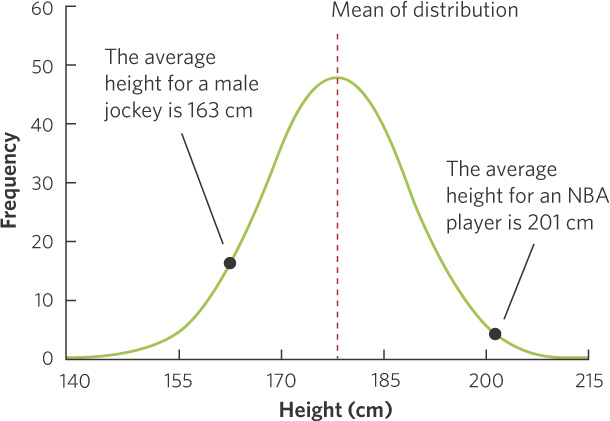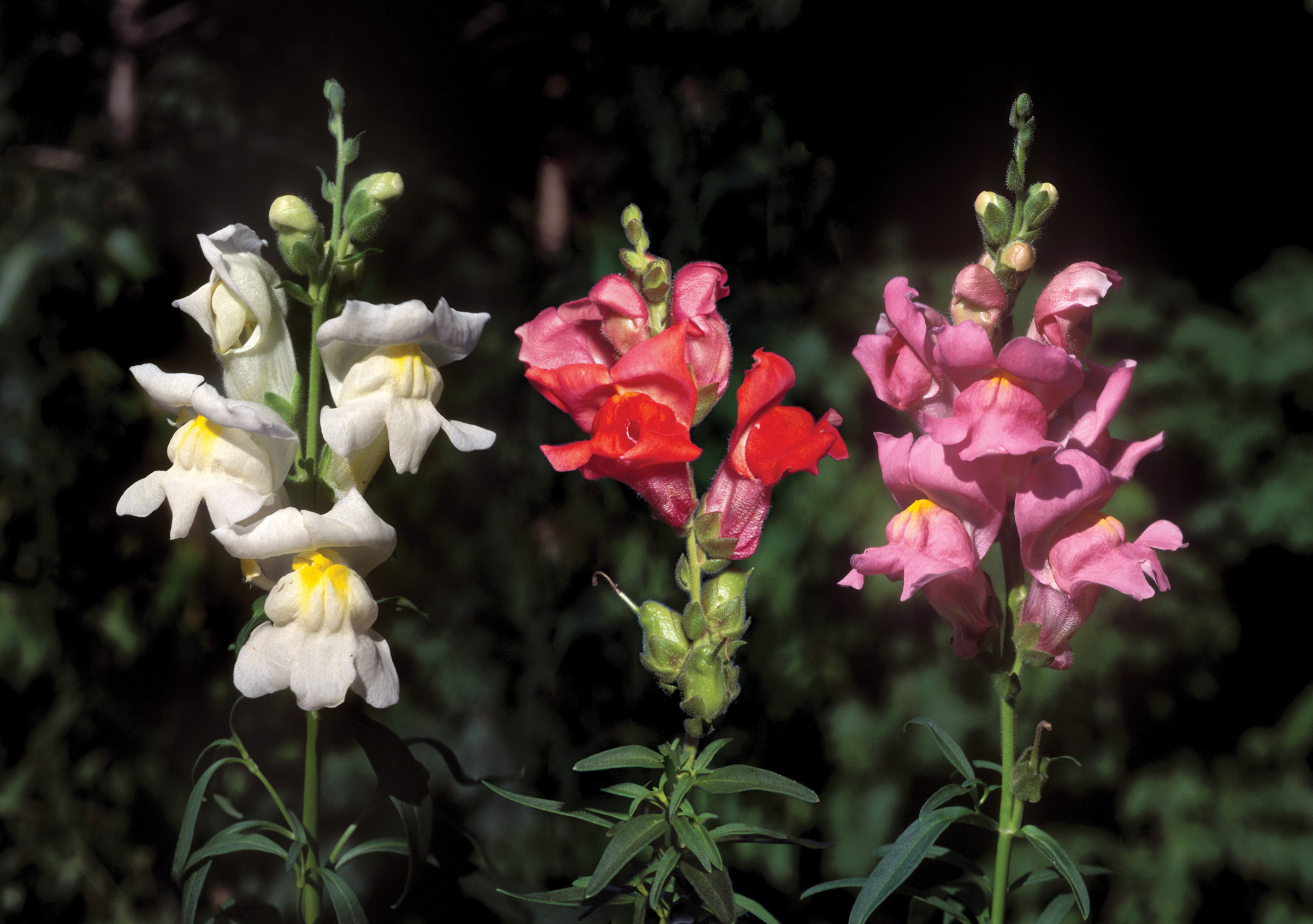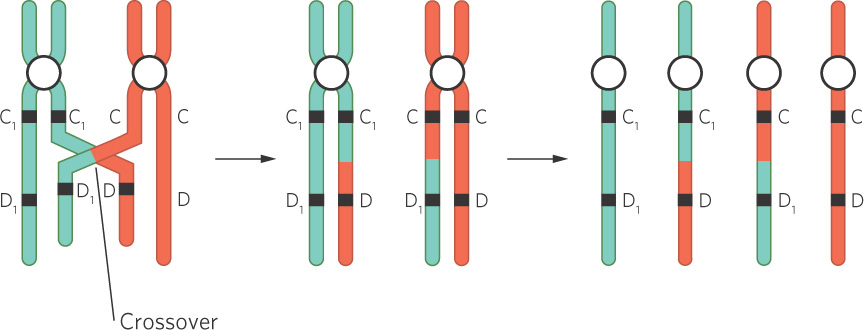The process of evolution depends on genetic variation
In Chapter 4 we discussed how the traits expressed by an individual are the outcome of genotypes and the environment interacting. As we saw in the example of finch beaks, when genetic variation is present, it allows evolution by natural selection. In this section we review the structure of DNA, the process of how genes help determine the phenotypes of organisms, and the process by which variation in genes is produced.
The Structure of DNA
Deoxyribonucleic acid (DNA) A molecule composed of two strands of nucleotides that are wound together into a shape known as a double helix.
Genetic information is contained in the molecule deoxyribonucleic acid, also known as DNA—a molecule composed of two strands that are wound together into a shape known as a double helix. Each strand is composed of subunits called nucleotides and each nucleotide is composed of a sugar, a phosphate group, and one of four different nitrogenous bases: adenine (A), thymine (T), cytosine (C), and guanine (G). Just as a sequence of letters signifies a particular meaning, or word, genetic information is coded in the particular order of the different nitrogenous bases. Long strands of DNA are wound around proteins into compact structures called chromosomes.
Chromosomes Compact structures consisting of long strands of DNA that are wound around proteins.
Genes and Alleles
Alleles Different forms of a particular gene.
Genes are regions of DNA that code for particular proteins, which in turn affect particular traits. Different forms of a particular gene are referred to as alleles. In diploid organisms—those having two sets of chromosomes—one allele comes from the mother’s gamete and the other comes from the father’s gamete. As you may recall, each gamete is haploid, meaning that it has just one set of chromosomes.
In many cases, a change in alleles can create differences in an organism’s phenotype. The ABO blood groups in humans, for example, are determined by which allele a person inherits from each parent—A, B, or O. The allele is responsible for production of the antigens A and B, which are molecules on the surface of our red blood cells that interact with the immune system. (Note that the O allele does not produce an antigen.) Individuals with blood type A have AA or AO genotypes; individuals with blood type B have BB or BO genotypes. All remaining individuals have either AB or OO genotypes. In this case, the link between the genotype and the phenotype is direct, and the pattern of inheritance is straightforward. For example, children of an AA father and a BB mother will all have the AB genotype.
163
Polygenic When a single trait is affected by several genes.
Whereas blood type is determined by different alleles on a single gene, polygenic traits reflect the effects of alleles from several genes. For example, eye color in humans is determined by at least three genes that control pigments in different parts of the iris of the eye. Patterns of phenotype inheritance that depend on interactions among multiple alleles can be quite complex.
Many phenotypes in a population can span a range of values because they are polygenic traits. Body size is a good example. Most populations exhibit a normal, or bell-shaped, distribution of body sizes, as shown in Figure 7.1. In this distribution, most individuals cluster near the middle of the range with progressively fewer located toward the upper and lower extremes. Part of this continuous variation might be due to environmental differences, such as the amount of resources available. However, much of the variation can be attributed to the actions of many genes, each with a relatively small influence on the value of the trait. If several genes influence body size, an individual’s size will depend on the mix of alleles for all of these genes. The tendency for individuals to be concentrated toward the center of the distribution reflects the relative improbability of an individual inheriting mostly alleles that code for large body size or mostly alleles that code for small body size. Think of this in terms of flipping pennies. The chance of getting 10 tails in a row (about 1 in 1,000) is much more remote than the chance of getting 5 heads and 5 tails (about 1 in 4).

Pleiotropy When a single gene affects multiple traits.
Whereas some genes only affect a single trait, such as size, other genes affect multiple traits, an effect referred to as pleiotropy. For example, chickens have a gene—known as the frizzle gene—which causes feathers to curl outward rather than to lay flat along the body. However, this gene causes other variations, including faster metabolism, slower digestion, and less frequent egg laying. When a gene has pleiotropic effects, any changes in the gene can have far-reaching effects on the traits of organisms.
Epistasis When the expression of one gene is controlled by another gene.
In some cases, the expression of one gene can be controlled by other genes. This is known as epistasis. In the case of mouse hair color, for example, there is a gene that determines whether a mouse will make black or brown hair pigments. However, there is a second gene that determines whether the hair will receive any pigments at all. If alleles in the second gene prevent pigments from being deposited in the hair, the alleles of the first gene become irrelevant and the mouse will have a white coat.
Dominant and Recessive Alleles
Every individual has two copies of each gene, one inherited from its mother and one from its father. Exceptions to this rule include genes located on sex chromosomes, the genes of organisms that reproduce by self-fertilization, haploid organisms, and organisms such as plants that alternate between haploid and diploid generations as part of their normal life cycle. An individual with two different alleles of a particular gene is said to be heterozygous for that gene, as in the case of a person with the AB blood type. An individual with two identical alleles is said to be homozygous, for example a person with AA blood type. When an individual is heterozygous, the two different alleles may produce an intermediate phenotype, as in the case of a person with the AB blood type that expresses both alleles. When both alleles contribute to the phenotype, the alleles are said to be codominant. Codominance is also found in the flower color of several species of plants (Figure 7.2). Alternatively, one allele may mask the expression of the other. In this case, the allele that is expressed is called dominant and the allele that is not expressed is called recessive. In domestic pigs, for example, the allele for white coat color is dominant and the allele for black coat color is recessive.

Heterozygous When an individual has two different alleles of a particular gene.
Homozygous When an individual has two identical alleles of a particular gene.
Codominant When two alleles both contribute to the phenotype.
Dominant An allele that masks the expression of the other allele.
Recessive An allele whose expression is masked by the presence of another allele.
164
Fortunately, most harmful alleles are recessive and are therefore not expressed in a heterozygous individual. Any dominant harmful alleles that might arise are expressed when homozygous or heterozygous. Because they reduce fitness, dominant harmful alleles are strongly selected against and removed from the population over time. In contrast, recessive harmful alleles are expressed when homozygous but not when heterozygous, so they can persist in a population because they are not selected against when they occur in heterozygous individuals. Examples of recessive harmful alleles in humans include those that cause sickle cell anemia and cystic fibrosis.
Gene pool The collection of alleles from all individuals in a population.
A gene pool consists of the alleles from all of the genes of every individual in a population. The gene pools of most populations that reproduce sexually contain substantial genetic variation. With the ABO blood type gene, for example, the human population of the United States includes 61 percent O alleles, 30 percent A alleles, and 9 percent B alleles. The proportions of these alleles vary among populations. People of Asian descent, for instance, tend to have higher frequencies of B alleles while people of Irish descent have higher frequencies of O alleles.
Sources of Genetic Variation
Random assortment The process of making haploid gametes in which the combination of alleles that are placed into a given gamete could be any combination of those possessed by the diploid parent.
Now that we understand the role of genes and alleles, we need to review how we obtain genetic variation in the traits of organisms. One of the most common ways to generate variation is through sexual reproduction. By combining a haploid sex cell of one parent with a haploid sex cell of another parent, new combinations of alleles can be produced in the offspring across many different chromosomes. The chromosomes in a haploid gamete are a random assortment of the chromosomes in the parent’s diploid cells, meaning that they can be any combination of chromosomes that the parent received from its mother and father. When an individual produces an egg cell, for example, some chromosomes in the egg will have come from the individual’s father whereas other chromosomes in the egg will have come from the individual’s mother. As we will see in Chapter 9, the creation of new gene combinations through sexual reproduction represents a major strategy for species to create offspring that are resistant to rapidly evolving parasites and pathogens.
Mutation A random change in the sequence of nucleotides in regions of DNA that either comprise a gene or control the expression of a gene.
Two additional ways genetic variation arises are through mutation and recombination. Mutation is a random change in the sequence of nucleotides in regions of DNA that either comprise a gene or control the expression of a gene. Mutations can occur anywhere along the chromosomes, although some regions of the chromosome can experience higher frequencies of mutation than others. Many mutations have no detectable effect and are referred to as silent, or synonymous, mutations. Other mutations may simply alter the appearance, physiology, or behavior of the individual. When phenotypic changes are better suited to the environment, these phenotypes will be favored by natural selection. Some mutations, however, can cause drastic, often lethal, changes in the phenotype. Many human genetic disorders, such as sickle cell anemia, Tay-Sachs disease, cystic fibrosis, and albinism, as well as tendencies to develop certain cancers and Alzheimer’s disease, are caused by single-nucleotide mutations of individual genes.
165
Genetic recombination is the reshuffling of genes that can occur as DNA is copied during meiosis, the process that creates haploid gametes from diploid parent cells. During meiosis, pairs of homologous chromosomes—one member of which is inherited from each parent—line up next to each other. When the two chromosomes in the pair do not exchange any DNA, we end up with haploid cells that contain unaltered chromosomes. However, sometimes the two chromosomes in the pair do exchange DNA, in a process known as crossing over, as shown in Figure 7.3. In some cases, crossing over can also occur between nonhomologous chromosomes. In either case, new genes are not being created, but new combinations of alleles are produced that have the potential to produce new phenotypes.

Recombination The reshuffling of genes that can occur as DNA is copied during meiosis and chromosomes exchange genetic material.
One of the best-known examples of recombination involves the immune system of vertebrates. Vertebrates face a diversity of pathogens that continually evolve so that they become better at attacking their hosts. To combat these ever-changing pathogens, vertebrates need an ever-changing immune system that can identify and destroy the pathogens. Recombination provides the mechanism to create the high genetic variation in the immune system that vertebrates need to match the rapid evolution of their parasites. We will talk much more about this issue in Chapter 9.